If you are looking for a way to add a network location or map an FTP drive and access files & folders on an FTP server, in Windows, natively, then this post may help you. You will be able to have one-click easy access to your files on networked locations via the Windows File Explorer.

How to Map FTP Drive in Windows
You can create or map a drive directly to your FTP site from within Windows.
Windows 11
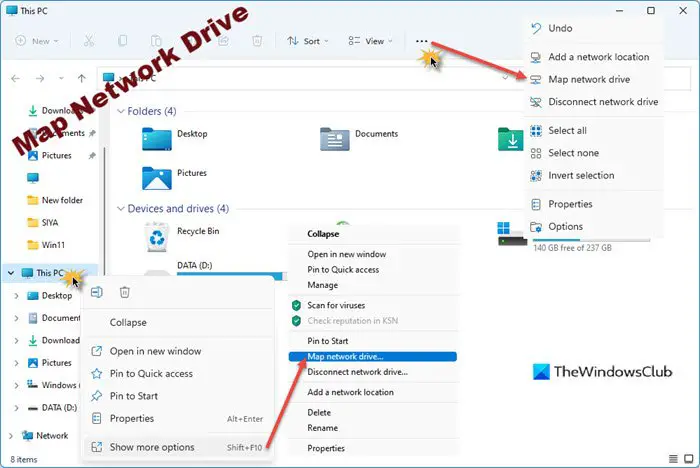
To start mapping a network drive in Windows 11:
- Open File Explorer
- in the left Navigation bar, right-click on This PC
- Select Show more options from the context menu
- Next select Map network drive.
- Alternatively, click on the 3-dotted See more link at the Explorer top menu bar
- Select Map network drive
- The wizard will open.
TIP: Network Drive Control lets you set up Advanced Drive Mapping Options
Windows 10
Open File Explorer > Computer (This PC). Right-click and select Map Network Drive.
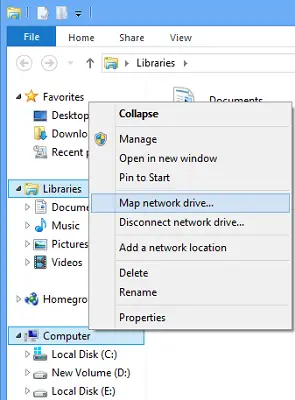
You can also use the Map network drive button:

It offers options to:
- Map network drive
- Disconnect network drive.
Having done this, in the wizard box which opens, type the FTP address or the path to your Network drive or browse to it using the Browse button. Your folder Properties must be set to Shared in order to map it as a network drive. You will get the setting under Properties > Sharing tab > Advanced Sharing > Check the Share this folder option.
Check the Reconnect at sign-in option to make the mapping permanent. If you plan to use credentials from the networked computer to access the shared folder, check the Connect using different credentials option and click OK. You will be asked to enter the username and password Next.
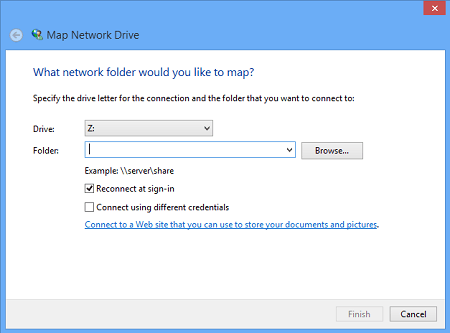
You will now have to enter the credentials for the user account, using the following format in the username name field so that your system knows which networked computer it is going to connect to – Computer\Username. Browse to your network folder for mapping and click OK.
Once you have done this, you will be able to see it in Explorer.
To map an FTP site, click on the Connect to a website that you can use to store your documents and pictures link to open the Add Network Location wizard.
Here you have to choose a custom network location and specify the location of your website, specify the login credentials that may be required and name the mapped FTP drive.
Read: How to map a Drive using Group Policy Preferences.
Add Network Location in Windows
If you wish to add a Network Location, when you right-click on My PC (See the first image), select Add a network location. From the Map FTP Drive box, you can also select the link at the bottom that reads, Connect to a website that you can use to store your documents and pictures. The Add Network Location Wizard will open. Click Next and then Choose a custom network location. Click Next again. Now specify the Internet or network address or browser to the location. Click Next.
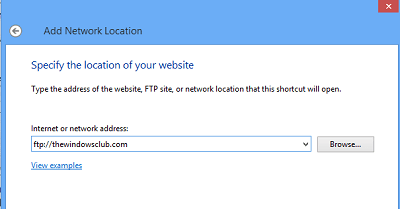
Uncheck Log for anonymously and give the username & password. Click on Next. Give a name to the networked location, when asked. Click Next again. Now select Open this network location when I click Finish.
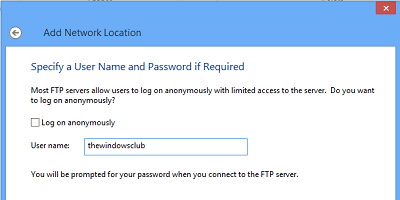
You will be asked to enter your credentials, and once you do so, you will be connected to your network drive or your FTP drive or your website.

This is quite useful if you need to connect your computers together for sharing files, store files online or run a website.
Read:
- The mapped network drive could not be created
- Mapped Network Drive not showing in Windows 11
- Unable to map Network drive.
Map a Network Drive using Command Line in Windows
To map Network Drives using the command line, in an elevated command prompt, you have to run the following command:
net use x: \\server\share /persistent:yes
Here x is the drive letter, and the /persistent:yes parameter makes it permanent.
You can read more about the Net use command, which lets you connect a computer to a shared resource on Technet.
Read: How to clear Mapped Network Drive Cache.
Map a Network Drive using PowerShell in Windows
To map Network Drives using Powershell, you have to run the following command:
New-PSDrive -Name x -PSProvider FileSystem -Root \\server\share -Persist
You can read more about New-PSDrive, which helps you create mapped network drives on MSDN.
Related: How to map WebDAV as a Network Drive.
NOTES:
- The folders you map should be set to SHARE before you can access them via drive letters
- If you are trying to access a drive from another computer, it should be ON and running; even if the computer is sleeping, you cannot access that drive
- You should know the credentials of the folder, computer, or website you are trying to map or connect as a network drive
- Download FTP Drive tool from KillProg.com. It makes several things including adding a drive letter easier
- You may want also to check out FtpUse, a free tool that helps you map an FTP server as a Local Disk Drive.
- Use Network Drive Control to make Windows automatically map network drives by network name when you log in
- Visual Subst is a free tool that lets you easily create Virtual Drives for your Folders & map Cloud Storage as Virtual Drives.
Also see:
- How to map OneDrive as Network Drive
- Mapping OneDrive for Business as a Network Drive
- Access FTP Server using Windows Command Prompt
- How to remove Map network drive Context Menu item
- How to access FTP Server using Notepad++.
If you want, you can also download and use one of these free FTP Clients for your Windows PC. How to set up and use SIP Server on Windows may also interest some of you.
This is 100% useless because you didn’t map a network drive, you added a network location. That text you click within the map network drive (connect to a website…) just sends you to the map network location which does NOT give you a drive letter as mapping a drive would.
I agree Derp on this, you never mapped anything, you only added a network location which is useless for me. I know how to do that already, what I need is to map an FTP as a Drive with a letter.
WebDrive can accomplish this…
http://www.webdrive.com/products/webdrive/
I have done this using Webdrive too. And it does a lot more than a traditional ftp client. http://www.webdrive.com/products/webdrive/
Webdrive sucks and Netdrive2 just plain doesn’t work. Netdrive 1 was great. Trying ExpanDrive 3 now.
Webdrive is useless since it downloads the entire file first.
Netdrive2 seems to do the same.
WebDrive, or any other FTP Client, will require you to
download the entire file before you can edit it. This has nothing to do
with which client you use- it’s a function of the way that FTP (and SFTP)
protocol works. It’s a file-based protocol, so the concept of
streaming or block-level access doesn’t exist in the protocol.
To save EVERYONE time, on the first picture on the right-click menu, instead of clicking “Map Network Drive” (Because you aren’t), it’s “Add a network location”.. To get the exact same results at the end of this article. Gah. If only I had skipped to the bottom to see what a disappointment this was before going step by step without thinking.
So what I’m getting here is that the procedure hasn’t changed to map a drive at all, other than now7 (puke) in Windows it’s “Add network location.”
No matter what I’m doing, I get “The folder you entered doesn’t appear to be valid. Please choose another.” Huh?
This has been my website since the late 90s, and a completely valid folder. I can connect with SmartFTP, but I don’t want to use 3rd party software.
Any ideas?
I ended up having to mount it as a network drive and then create a shortcut to it underneath my C: drive.
Wrong: the FTP protocol allows to read file fragments.
In order to read a file fragment, a FTP client can
get the file size,
seek to a position,
start a transfer, abort it once the fragment is transferred.
For a write operation, I don’t know it is is possible too.
Bob,
Good point and thanks for the follow up. You are correct that it transfers in packets.
However, you can not access the individual packets through an application to begin editing. Aborting a transfer in between packets is different than being able to edit while still downloading.
If you need a free solution: http://www.ferrobackup.com/ftpuse/
$49.95/year for use on one PC…
You are right and i am looking for another solution cause it MUST have a letter. (Other applications can not use simple network location)
that is a great tool. The only issue is when you want to auto-mount and store the login details. It does not provide an encrypted environment to store the login/password. Other than that is fast and stable. Thanks for the share!
I don’t understand what you did ?
This stinks only paid solutions to this problem, arghh.
It’s actually better that way – it makes you make a home-brew password batch file. There are password-stealing trojans out there which look in known paths and registry keys to steal passwords. When the program doesn’t save them and you have an arbitrary batch file, it won’t be targeted.
But that ftpuse is free and it works well.
Except FTPUse doesn’t work. When I map a FTP account as a drive, I get informed the operation was successful, but I don’t see the FTP account mapped as a drive in Windows Explorer.
It works for me. Make sure you used the right parameters. Also try connecting to different servers and try different clients to the server that didn’t work with ftpuse. There are tricky gotchas that can only affect certain combinations of software used. I connected directly (no NAT) and the server was proftpd. I remember that IIS sends non-standard path without the leading “/”.
http://ftp.acme com /USER (ftp.acme com is an example, not real) the operation is successful but as I mentioned I don’t see the drive in Windows Explorer ? I also tried http://ftp.microsoft.com, once again successful but no drive mapped in Window Explorer ?
If you got it to work, I’d really like to know how because FTP Use has never worked for me, and there are only so many parameters one can try to map a FTP account to a drive in Windows(7,8,10); maybe we can talk off this site via email or skype ?
i have also got a lot of problems to get it working, now it’s ok …you have to do it this way… with the password at the end it’s not working, password direvtly after ftp locations followed by the username and port…
FTPUSE X: yourname.dyndns.org/programs yourpassword /USER:username /PORT:8312
FTPUSE X: thedomainname.com/something [myPassword] /USER:[username] /PORT: 21
The above command results in the operation was successful, but there is no drive listed in Windows Explorer which is linked to the domain account or FTP domain ?
What you are saying is;
FTPUSE I: http://ftp.gofiles.com/ruu /USER:rtefgr /PORT:21
That is the command I did, I also did;
FTPUSE I: gofiles.com/ruu /USER:rtefgr /PORT:21
Either didn’t work ? I was informed the operation completed successful but I don’t see any drive I in Windows Explorer linked to the ftp account ?
If you, Johan or Zdenek22 want to try to solve by communicating via email we may be able to solve ?
Nothing is working !
are you on another external network then yours? because when you’re home on your own network it’s normal it doesn’t work…. you can test it to log in on the network from on other provider then yours….also is it nescessary that your dis-session keeps open, when you close your terminal window it stops working….when you do’t have enouph memory or harddisc space you get also problems….
netdrive can do the same but there you have the problem that ftp uploads not being automaticly updated on your netdrive unless you log-out en log-inn back…. you can find on the net (free) old versions…
It sounds as if you are saying, a home network won’t work, in that case I’m not trying to connect to a home network, I’m trying to map an FTP account as a drive in Windows Explorer, no matter what options I try with FTPUse, the operation is always successful, but, nothing is successful because I don’t have the FTP account mapped as a drive in Windows Explorer.
I’ve try using http://ftp.domain.com, as well as not using the http://ftp., rather domain.com and nothing works, although FTPUse tells me everything was successful, but it wasn’t otherwise I would have the FTP account mapped as a drive in Windows Explorer. This is extremely frustrating, it works for you Johan, as well as Zdenek it’s not working for myself and there are only so many commands in FTPUse, I don’t know what I’m doing wrong. I’d like to get FTPUse working, because also it’s free, compared to the others which want a annual or monthly fee.
The words “map” “mapped” or “drive” should not be in this article anywhere.
Just click bait and misleading.
You should not be writing articles if you don’t know the difference between a mapped drive and a network location.
Thanks a lot it was awesome….worked perfectly for me.
How can you expect it to work when you never supplied all the required parameters? Like the drive letter? I have this: ftpuse R: address password /USER:username /PORT:21 /HIDE
where R: is the drive letter. The address is NOT prefixed with ftp://. And it needs all the dots, you are lacking the dot in your com.
Absolutely useless. You didn’t map a drive. Applications has no acces to that network resource.
Damn Man. Is there no solution to this? You would think windows should have simplified this by now. This is the era where companies are embracing the cloud for web applications and this kind of complication is just unbearable. I have no solution for my client for what would have otherwise been a massive project.
FTPUSE E: /USER: /PORT:21
Connecting…
Connected.
The operation completed successfully
There is no Drive E: in explorer ?
That syntax is probably wrong. You need to pay attention to details such as spaces, or the lack thereof. There is no space in /USER:myname . Your domain=”” thing is also dubious – you are supposed to have the drive letter, server address and password literally and consecutively, just separated with a space. This example makes it easy to understand what’s what. Make sure you don’t add or remove any extra spaces.
ftpuse L: 10.20.30.40 supersecret /USER:johndoe /PORT:21 /HIDE
ftpuse Y: http://ftp.domainName /USER:UserName /PORT:XXXX /HIDE
Connecting…
Read Timeout ?
You need to pay more attention. The password goes before the options. Be accurate. And you most likely put a wrong domain too. Using “ftp.” as a subdomain has been on the decline for some time and chances are it won’t work at all.
It would be best if you copy-pasted the given example and then only replaced the relevant strings. Do not make up things.
You’ve repeatedly told me, I’m doing this wrong; I’m doing that wrong when all I’ve been going in circles over and over and over again with your suggestions You tell me that I’m making things up, why would I make things up when I want something to work and that isn’t explained in the documentation of the program ?
Therefore copying and pasting what you posted and filling in the blanks surfaced this error:
Connecting…
Socket Error # 10060
Connection timed out.
That is after entering the correct login password, and the correct login.
FTPUSE E: /USER: /PORT:XX /HIDE
I won’t be surprised if you tell me the above command is wrong, as you always seem to find fault in what I’m doing.
This is the first time you actually wrote the syntax correctly here. You know, computers aren’t people, they need it exactly to the letter. I can’t obviously check if the details you provided were correct or if there wasn’t something blocking it at your site. Try connecting with a different FTP program to check that the details you have work at that particular computer, then use them exactly in the command line.
I checked it on Windows Server 2003; if you have a different version of Windows, that might be it.
I can successfully login to the account which I tried to login with FTPUSE on Windows10; but on Windows10 I get the error posted in my last reply.
FtpUse works partially, notepad++ is able to writ tot the mapped drive (remote ftp server) but MS office applications fail for some strange reason..
Hey, Christopher.
Were you finally able to get this working for you?
I have spent the last 2 days trying to solve the same issue but FtpUse does not work for me on Windows Server 2012 R2. I went as far as changing the Dokan version and trying many other things. In debug mode I get error 1450 referring to storage driver problems.
I completely forgot about this. Now that it was brought to my attention, I’m going to try one more time; hoping I can get it to work. I’ll post a follow up regardless the outcome.